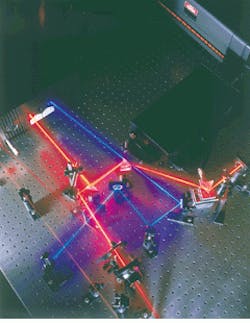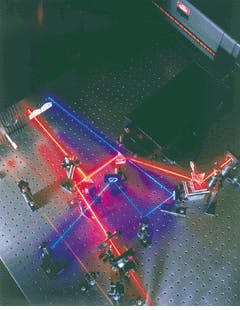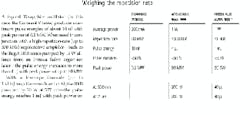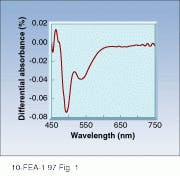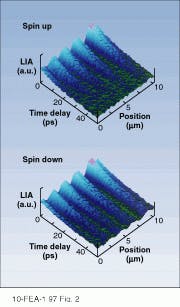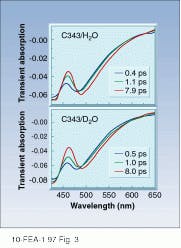Regenerative amplifiers raise Ti:sapphire laser output
Regenerative amplifiers raise Ti:sapphire laser output
Commercial regenerative amplifiers for modelocked Ti:sapphire lasers are optimized for either high repetition rate or high pulse energy, so application needs govern choice.
Many applications of modelocked Ti:sapphire lasers require amplification of their low-energy (typically 10-nJ) output pulses. This need is addressed by regenerative amplifiers, which have been commercially available since 1992. Commercial systems fall into two broad categories: low-repetition-rate (up to a few kilohertz) systems that offer high pulse energy with peak power on the order of tens of gigawatts and high-repetition-rate (up to 300 kHz) systems with peak power approaching 100 MW and pulse energies in the 5-µJ range. Both types have advantages and limitations that must be matched to the requirements of specific applications.
In a regenerative amplifier a single pulse from a seed laser enters the amplifier cavity and passes through the Ti:sapphire crystal gain element. The crystal is excited either by a continuous-wave (CW) or Q-switched pump laser. After the seed pulse has made multiple passes through the gain crystal, the amplified pulse exits the amplifier. The whole process is then repeated with another seed pulse. Stretching (chirping) and subsequent recompression of the seed pulse avoids high peak power--with consequent damage and self-phase modulation--within the amplifier.
The average output power of a typical regenerative amplifier is about 1 W, depending on the choice of pump laser. The repetition rate of a regenerative amplifier is many orders of magnitude lower than the original seed laser, however, so the pulse energy and peak power are many times higher--how much higher depends on the repetition rate (see box on p. 84).
Matching performance with application
Selecting the regenerative amplifier that best meets the needs of a given application requires understanding how various factors affecting system performance translate into either benefits or limitations for that application.
Scanning. The main benefit of a high-repetition-rate system is high-speed data accumulation. Hence applications that require signal averaging of many data points or acquisition of two- or three-dimensional data by rastering a focused laser spot will benefit. The high-speed data accumulation is of particular importance when overall data-acquisition times must be minimized, such as in biological imaging. Ignoring other factors for simplicity, a 300-times-higher repetition rate translates into a 300X reduction in data acquisition time or a increase in data signal-to-noise ratio (S/N).
Low S/N experiments. Obtaining a high S/N in applications that produce inherently small single-shot signals requires the high pulse energy and peak power of a 1-kHz repetition-rate system. Such low-signal applications include gas-phase experiments in which sample-number density is low, experiments that rely on low-probability events, or those involving very weak nonlinear processes or saturation effects.
Alternative wavelengths. Nonlinear processes are frequently used to produce other wavelengths in ultrafast systems. These include optical parametric amplifiers (OPAs), a white-light continuum generator, and frequency doubling and mixing. An OPA offers a relatively simple method of producing widely tunable output from a Ti:sapphire-based system, generating two longer wavelengths from a single input wavelength.
Both high- and low-repetition-rate regenerative amplifiers deliver the single-pulse peak power needed for driving one or more OPAs, as well as for generating a white-light continuum. When driving a "cascade" of sequential nonlinear processes, however, a low-repetition-rate system is preferable.
Energy overload and sample relaxation. High pulse energy and high repetition rate can both be disadvantageous. When a beam is tightly focused (to a diameter of a few microns) into a solid or liquid sample, for instance, the threshold for continuum generation is only 1 µJ. Other nonlinear effects will appear at even lower energies.
A high repetition rate can be a problem for systems with slow relaxation times because the experimental system must have time to completely re-equilibrate before the next laser pulse arrives. At a repetition rate of 300 kHz, this means the relaxation time must be 0.5 µs or shorter.
The practical impact of all these factors is best illustrated by actual applications. A group of researchers at the National Renewable Energy Laboratory (NREL; Golden, CO), is using ultrafast techniques to understand the fundamental physics of semiconductor materials and devices that will lead to more-efficient solar cells. At the University of California, Santa Barbara (UCSB; Santa Barbara, CA), researchers are working with ultrafast lasers in the field of magnetoelectronics. And at the Laboratory of Photochemistry, CEA/Saclay/ Service de Chimie Moléculaire, France, another group is studying solvation of laser dyes.
Improving solar cell efficiency
A promising new photovoltaic technologies under study at NREL is based on a cadmium telluride/cadmium sulfide (CdTe/CdS) junction. In these photovoltaic cells, a CdS layer is first deposited on a float-glass superstrate followed by a CdTe layer, which absorbs most of the solar spectrum below 820 nm. The CdS/CdTe junction potential serves to separate the light-generated charge carriers (electrons and holes) produced in the CdTe layer.
Although the float glass transmits wavelengths longer than 400 nm, the 2.5 eV bandgap of CdS causes this material to absorb at wavelengths below 500 nm. Due to as-yet poorly understood processes, the charge carriers generated in the CdS layer are not collected. Explains Dean Levi of NREL, "If we could find some way to collect the carriers from the CdS layer, we could boost solar cell efficiency by as much as 20%, that is, increase the overall operating efficiency from, say, 15% to 17%."
The researchers are using ultrafast pump-probe techniques to investigate the relaxation and recombination pathways in the CdS window layer of CdTe/CdS solar cells. Specifically, they generate charge carriers with the 400-nm frequency-doubled output of a high-repetition-rate regenerative amplifier (RegA 9000; see photo on cover and on p. 83). They then study the relaxation of these carriers using a white-light continuum for differential absorption (see Fig. 1).
Levi explains the choice of a high-repetition-rate amplifier: "Each pulse represents a single, low-S/N experiment. We build up high-S/N data by averaging millions of such experiments. At the same time, 300 kHz is still slow enough that the 1-µs carrier relaxation is always complete before the next laser pulse. Finally, pulse energies in the 10- to 100-nJ range provide ample photon flux for the carrier densities we need to generate."
Magnetoelectronic research
Anticipating the time when the fundamental physics of semiconductors may limit the speed and complexity of conventional integrated circuits (ICs), a growing number of research groups are investigating magnetoelectronics. One such group from the physics department at UCSB is headed by David Awschalom. He explains, "Whereas conventional ICs use gate voltages to modulate currents, the idea of magnetoelectronics is to control (or flip) the spin states of electrons or holes. Our research is at the fundamental level; we are studying spin transport and scattering of electrons in semiconductor heterostructures that are magnetically doped."
In collaboration with Nitin Samarth in the physics department at Pennsylvania State University (University Park, PA), Awschalom`s group fabricates novel nanometer-scale semiconductor structures, such as quantum dots. These structures are cooled to 4 K within magnetic fields up to 8 tesla. Pulses from a high-repetition-rate amplifier system and a tunable OPA are used to make high-resolution absorption measurements. "We use a pulse centered at 480 nm to excite a population of charge carriers that are then interrogated by a synchronized white-light continuum pulse," says Awschalom. "In order to probe a small number of quantum dots, we use near-field scanning magneto-optical spectroscopy techniques. In this case, the 100-nm tip of a tapered optical fiber defines a near-field aperture, which is scanned across the semiconductor surface. The result is optical data with a spatial resolution of 100 nm and temporal resolution of 100 fs."
Luminescence and absorption measurements reveal details about electronic relaxation (see Fig. 2). Polarization optics enable the researchers to monitor the Faraday rotation of the probe pulse, which yields information about the relaxation (reorientation) of the electron spin.
Both groups of researchers are working in solid-state physics so it is not surprising that Awschalom selected a high-repetition-rate amplifier for reasons similar to those given by Levi at NREL. Awschalom explains, "With this type of high-resolution scanning spectroscopy, every experiment involves repeating multiple full spectroscopic scans at every point on the surface. A high repetition rate avoids unacceptably long data-acquisition times. In addition, since we`re using a small focused spot, we couldn`t use a high-pulse-energy system as this would cause nonlinear effects and damage to these microscopic structures."
Aqueous solvation of laser dyes
A group headed by Jean-Claude Mialocq at the CEA`s Laboratory of Photochemistry is using a high-pulse-energy system to study solvation of laser dyes. This work has potential implications ranging from photobiology with fluorescent markers to isotope separation using high-powered dye lasers.
In a typical experiment, a thin cell containing a solution of laser dye is irradiated with frequency-doubled (400 nm) or frequency-tripled (267 nm) output pulses from a low-repetition rate system (Alpha-1000). Part of the output is used to generate a white-light continuum pulse, which is also propagated through the sample. The transmitted white light is then dispersed by a CCD-based spectrograph. Varying the delay between the pump pulse and the continuum allows the time evolution of transient absorption spectra to be recorded. Spectra are normalized by subtracting "probe-only" data from "pump-probe" data.
In a typical data set for coumarin 343 dye in aqueous solution the negative absorption feature at 400 nm is due to ground-state population depletion (photobleaching), whereas the negative absorption peak at 480-490 nm is caused by stimulated emission of the S1 excited state (see Fig. 3). The long-wavelength positive absorption is due to SN ¨ S1 transitions. Temporal changes in these spectral features yield important information on the dynamic interactions between the dye molecule and surrounding water (H2O) or heavy water (D2O) molecules. Both the red shift and the spectral narrowing of the stimulated emission band around 480 nm proceed faster in H2O because the dynamics are dominated by the diffusion of the solvent molecules.
According to Mialocq, the high pulse energy is critical. "This type of data relies on the ability to produce a significant excited-state population with each laser pulse, which dictates a high pulse energy," he says. "But we need to use the second or third harmonic of the amplifier to excite these dyes. In addition, to avoid compromising temporal resolution and chirping the delay by GVD [group velocity dispersion], we have to use very short (less than 0.2 cm) path lengths. This further limits the signal per pulse. This is why we need the high-energy pulses (up to 200 µJ at 400 nm) from the Alpha-1000 [amplifier]. Also, the 1-kHz rep rate is more than sufficient to produce an acceptable S/N ratio."
As Mialocq`s group has found out, high-pulse-energy regenerative amplifiers are extending the capabilities of Ti:sapphire lasers and enabling a wide range of cutting-edge research applications in ultrafast science. Manufacturers now offer a variety of systems, allowing researchers in disparate fields to select a system that is closely optimized to the needs of their specific applications. o
ACKNOWLEDGMENT
The author wishes to acknowledge helpful discussions with Dr. Francois Salin of the Laboratoire d`Optic Applique, CNRS, Palaiseau, France.
Regenerative amplifier combined with optical parametric amplifier provides researchers in the Photovoltaics and Basic Sciences teams at NREL access to femtosecond output at wavelengths ranging from ultraviolet through near-infrared. Blue light generates charge carriers in solar-cell material; these ultrafast pump-probe experiments aim to improve the understanding and performance of solar cells.
FIGURE 1. Output from a high-repetition-rate regenerative amplifier frequency-doubled to 400 nm induces transparency in the CdS window layer of CdTe/CdS solar cells. The transparency is produced by electrons in the CdS conduction band and the CdSxTe1-x layer at the interface. The pump/probe delay time is 50 ps.
FIGURE 2. Spatiotemporally resolved near-field luminescence intensity autocorrelation (LIA) images permit monitoring optically excited excitons within a single diluted magnetic semiconductor quantum well for both spin-up (top) and spin-down (bottom) conditions. The spatial corrugations correspond to regions that have been disordered by ion implantation using a focused beam of Ga+ ions to quench luminescence.
FIGURE 3. Dynamic interaction between coumarin 343 (C343) dye molecule and water is illustrated by the time evolution of transient absorption spectra of C343 dissolved in water. The stimulated emission peak around 475 nm shifts and narrows with time. Both the red shift and the spectral narrowing proceed faster in H2O because the dynamics are dominated by the diffusion of the solvent molecules.
